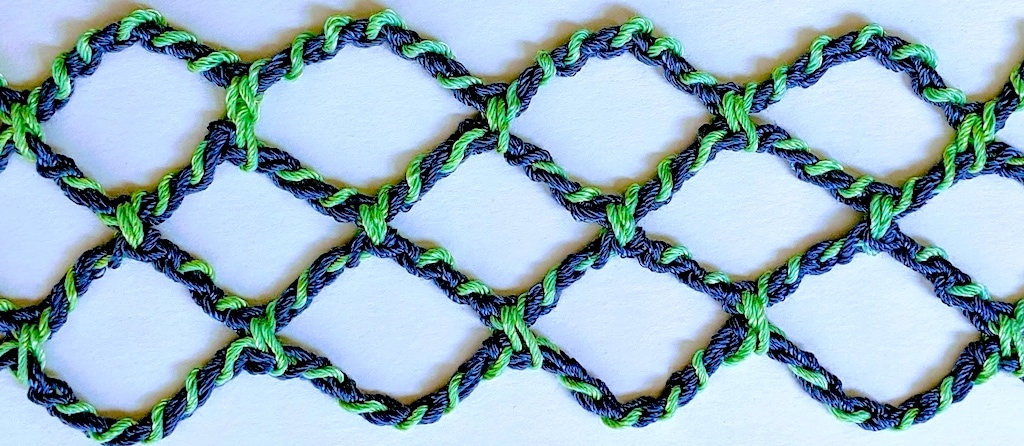
“What Is Crochet, Really?” was first published as issue #103 of Vashti’s Crochet Inspirations Newsletter. I sent it to 8,043 subscribers on October 9, 2020 with the title, “The Big Picture of Crochet”. I’ve updated the third paragraph (“This idea for a newsletter topic…”) as of Nov. 2, 2020.
I have a fresh big picture of crochet to report.
I’ve worried about whether you’d be interested in my “what is crochet” thoughts, but you know what? It’s crochet theory, which we don’t have enough of, so I’m probably not alone in pondering it.
For help in my quest I turned to national libraries, big crochet sites, encyclopedias, and academia. How does crochet fit into the larger world? How is it defined by and for non-crocheters, versus crocheters? Within the subject of crochet, how is its huge variety organized into subtopics?
This idea for a newsletter topic grabbed hold of me thanks to three writers (I’ve listed all mentioned sources at the bottom): Cary Karp, Rachel Maines, and Sue Perez. Cary’s Loopholes blog has several thought-provoking posts and published articles about crochet history and structure; his “Defining Crochet” article had me mulling “what really is crochet” for weeks. It turns out that my “how does crochet fit into the larger world” question is addressed in Rachel’s book. Sue’s new category-crossing crochet book was an indirect trigger (see Links at the bottom).
Defining Crochet’s Big Picture
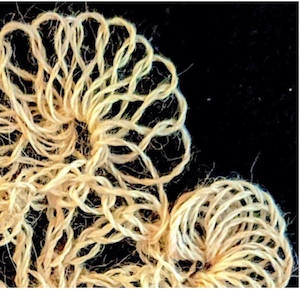
Color me picky but I expect a definition of crochet to capture its distinctiveness and scope. Of the definitions and descriptions I sampled, almost none do. I grew alarmed when I learned that researchers and museum curators rely on definitions of crochet, not the tool used, to identify whether a textile artifact was crocheted or not. In many cases the tool used to make it is missing.
So, I fantasized about what my ideal crochet definition would include. I’d want it to aid others in identifying any kind of crochet. It became wildly inspiring.
My Working Definition
Crochet is a pathway of chain loops that embed permanent metadata in every stitch. A hooked tool is necessary to get many of the effects. As crochet’s own measuring unit, the chain loop is a building block that regulates stitch gauge and row gauge. All crochet stitches are built of chain loops, which also show in a stitch’s characteristic “chain tops”. Tall stitches are sequences of chain loops that catch yarn-over loops in them, and the Tunisian return pass is a sequence of chain loops that catch forward pass loops in them.
A slip stitch is a chain loop that has caught another loop in it of any type, of any stitch, of any material, in any direction. In this sense the slip stitch is a microcosm of the crochet macrocosm.
Crocheting is the only known textile method in history that explores and expresses all of the chain loop’s remarkable properties.
We use other loops in crochet too, but it’s chain loops that “hook them up”, space them apart at regular intervals, prevent previous loops from unraveling, and many more classic crochet functions.

Museum Curators are on Notice
The signature loop of crochet—the chain loop—is not to be underestimated. It takes so many forms, and performs so many functions, that it takes training to be able to track the pathway from the first stitch to the last in a crocheted artifact.
With additional training you can recognize circuitous and compound paths. And, get detailed readouts from the chain loop metadata, like whether some or all were crocheted left-handed, or with yarn unders instead of overs, or inverse.
The Superpowers
The chain loop itself is looking like a superpower. It even synthesizes building-block elements of other textile methods. The superpowers below point to crochet being an ingenious innovation in the evolution of textile structures.
A textile researcher needs to be aware of them, no?
- Crochet is self-launching, self-supporting, & self-finishing.
- Crochet is a logically consistent system of architecture based on its own unit of three-dimensional measurement.
- Crochet is freely, infinitely expressive.
- Entry-level crochet is easy to learn, and then master simple satisfying projects…
- Crochet is wildly appealing and accessible to all social classes.
1. Crochet is self-launching, self-supporting, & self-finishing.
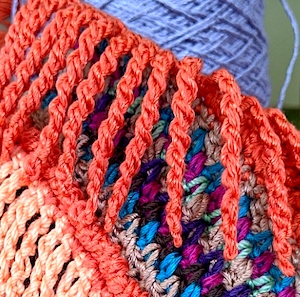
Only their top loops are connected.
This sets it apart from many textile techniques. Crochet makes a base for itself “out of thin air”. If chain stitches were all we used for foundations, it would already be a great power; but we can use other crochet stitches that can be customized to projects of any size and shape. New foundation stitches continue to be developed.
No embroidery hoops and canvases to prepare, no knotting or buying netting for lacis, no knitting cast ons to memorize, no mounting on bobbin lace pillows, no macrame setups, no looms for weaving or knitting, no adjusting the grain of fabric (etc.) before sewing.
Ending is as easy as beginning. Just pull the end through the last loop. No “binding off” step is needed nor other special release procedures from a frame, loom, or support. All edges of crochet pieces are self-finishing by default, and can be designed to have a fancier built-in finish.
If researchers classified textile methods according to how free of external foundations they are, I’d bet the winner, crochet, would be studied more.
2. Crochet is a logically consistent system of architecture based on its own unit of three-dimensional measurement.
This makes plotting the construction of a new thing coherent and intuitive. It automatically builds in a rich palette of equivalents and substitutions.
These power tools are native to crochet; they needn’t be “borrowed” from some other textile method. (It also means it’s an excellent way to teach reasoning to children.) I don’t see this discussed much, do you?

Color changes reveal that the big difference between Tunisian & regular crochet is just 90°. (They also show all the textures we can get with linked stitches.)
For each band of Tunisian Crochet rows: the color changes after each return pass. In other words, a horizontal stripe of color is a complete row pair (forward pass and return pass).
For each band of linked stitches: the color alternates per stitch. In other words, each vertical stripe of color is one tall stitch of regular crochet.
I’ve blogged about linked stitches.
3. Crochet is freely, infinitely expressive.
At any moment while crocheting, stitches can be of any height, type and mixture of types. They can travel in any direction, and connect securely to any other loop, or to loop stand-ins (such as hole-punched leather, card stock, or a ring. Or, just make its own its own holes in something if the crochet hook has a sharpened tip).
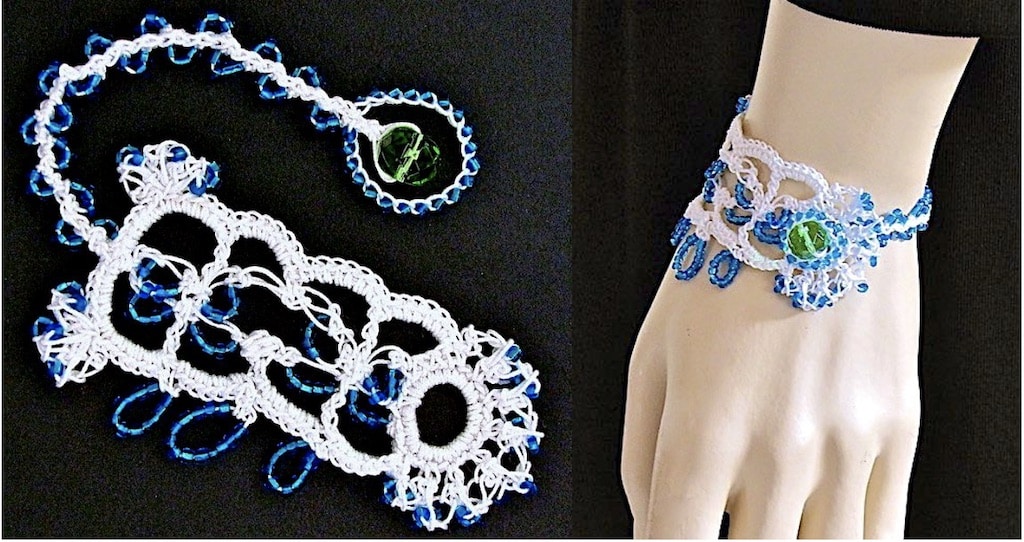
4. Entry-level crochet is easy to learn, and then master simple satisfying projects…
…even though crochet itself is infinitely varied and complex. I was hooked at age nine. Not all textile crafts offer quick and easy satisfaction to beginners. This ease + complexity makes crochet infinitely customizable to age, skill, and imagination.
A researcher shouldn’t expect a crochet artifact to be a simple fabric. Or even resemble one!
This crochet power must be super because I’ve seen it get twisted into a shortcoming when crochet is defined only by how it is simple, quick, and easy—as if there’s not much depth, complexity, or nuance to it.
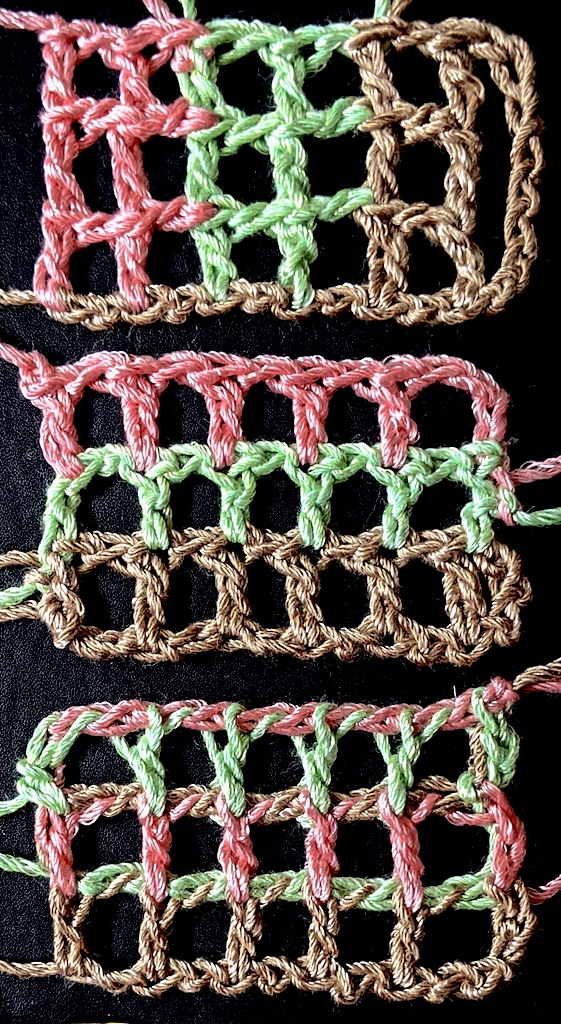
Seemingly Similar Filet Stitches
The middle swatch of the three is the classic filet mesh that beginners learn: one double crochet, then one chain stitch. Each complete row is a different color.
Below it is Tunisian filet crochet. The yarn color changes at the end of each forward pass and again at the end of each return pass (a.k.a. the “3-color Tunisian” that is more commonly used for Tunisian simple stitch, not filet).
The uppermost swatch is just one row of very tall linked stitches. A visual illusion makes it tricky to see how it works: the places where the tall stitch links to the one before it are elongated links. They appear to be double crochet stitches worked at a right angle to the vertical parts of the tall stitches.
I left the ten turning chains (in tan color along the right edge) visible to help you see it. I changed the yarn color after every 2nd tall stitch.
5. Crochet is wildly appealing and accessible to all social classes.
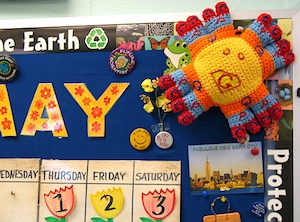
The tools and materials are plentiful, and easy to find, use, and afford. The variety of them adds to the fun.
I count this as a superpower because periodically, waves of crochet’s popularity crest at frenzied highs and yet, incredibly, this has been used against it. Most of us have seen crochet dismissed here and there as déclassé, but it’s not even true that only the “lower classes” have been more thrilled with it.
The issue seems to be that too many people loved/(love!) it, regardless of class. It’s democratizing.
“Crochet and tatting were thriving at nearly all economic levels in the United States and the United Kingdom by the end of the nineteenth century”. (Maines, p. 66). Middle-class women were crocheting by 1838, and by the early 1850’s it was greatly favored: “It was therefore one of the few needlecrafts thought suitable for a ‘lady’ and ‘the lower orders’.” (Warren, p. 40).
[W]hen Madam embroiders or crochets, her maid thinks that she has the right to do the same.
1890’s Denmark
“Crochet—A Bone of Contention” is a section in Lis Paludan’s Crochet: History and Technique. It describes feuding between social classes over crochet in 1890’s Denmark: “[W]hen Madam embroiders or crochets, her maid thinks that she has the right to do the same.” That’s pretty telling.
The Crochet Categories
I don’t have a working solution to my last question, “within the subject of crochet, how is its huge variety organized into subtopics?”.
I have some interesting angles on this to share, though.
What Big Libraries Do
The Library of Congress (LOC) and the national libraries of Germany (DNB) and France (BNF) use a few rather random subcategories under Crochet.
LOC: Bead crochet, Doilies, Lace and lace making, Yarn bombing.
DNB: Filet crochet, Hairpin Lace? (Gabelhäkeln), Broomstick Lace? (Schlingenhäkeln), Tunisian crochet, and “Woven knit crochet” (Webstrickhäkeln).
BNF: Crochet lace, and Crochet rug (Tapis au crochet).
What Ravelry Does
Ravelry is an amazing database when it comes to projects and patterns! There’s much more to crochet than what you can make with it, though.
As a database of varieties of crochet stitches and techniques—as a map of crochet itself—it’s kind of thin.
Did you know that Ravelry won’t list a technique or stitch type as a searchable attribute until at least 100 patterns use it? Currently there are 17 crochet techniques listed; looks like clones knot is the newest listing at 104 patterns (as of Oct. 1, 2020).
Ravelry lists many more searchable attributes, but almost all are based on knit patterns. For example, of 20 Regional/Ethnic Styles, like Guernsey/Gansey with zero crochet, only three have over 100 crochet patterns.
Dee Stanziano’s 136 Kinds of Crochet
I get a richer sense of the range of crochet experiences from Dee Stanziano’s Kinds of Crochet list. By 2013 she had 136 listings. Of these, almost 50 are alternate terms for a listing, so I counted 90 distinct kinds. (The alternate terms are valuable as historical or regional references.) Of the 90, a few are project types like antimacassars, and stitch patterns like Catherine’s Wheel.
It’s a great place to start.
DesigningVashti News
Three Newsletter Developments
- Issue #3 (Limpets, 2010) is now updated and it’s a doozy! I geeked out. Now I can use it as a one-stop reference. It includes a timeline and a table of terms.
- Updated past issues will now display in a new directory. There are only two there now but it will start filling up.
- Furthermore, I’ve posted a progress log of all issues, with links to them as they become available. Besides allowing both of us a glance at where things stand, I can now link to the page from anywhere else and the link won’t break later.
These three are part of a big update I’m doing to the DesigningVashti website. It will be more information-based, rather than structured as primarily an e-commerce shop.
I’m getting ready to have online classes & videos at the site, woo-hoo! I wrote a little about how my first online classes went for CGOA.
More Site Updates
- Class Resource Pages are now all displayed as “topic cards” in one directory.
- Updated two blog posts about clothes for crochet conferences. Most of the photos have never been posted before:
- “My Ideal Conference Clothes” (with a new “Activism” section)
- “Best Crochet Conference Shoes Ever“
Links I Enjoyed
- Sue Perez just came out with a new crochet technique book and it’s awesome! Read my review of it. It’s called Live Loop Cables in Crochet. This link goes directly to its Amazon page.
- Wow, what a fresh crochet fashion mini-video!
- Celebrity crochet trend: the Harry Styles cardigan.
Sources
Karp, C. (2018). “Defining Crochet” in Textile History, 49:2, 208-223, DOI: 10.1080/00404969.2018.1491689.
Karp. C. (2020). “Evolution in Early Crochet: From Flat-Hook Knitting to Slip-Stitch Crochet” — PieceWork, Winter 2020, pp. 12–12.
Maines, R. (2009). Hedonizing technologies: Paths to pleasure in hobbies and leisure. Baltimore: Johns Hopkins University Press.
Paludan, L. (1995). Crochet: History & technique. Loveland, CO: Interweave Press.
Warren, G. (1976). A stitch in time: Victorian and Edwardian needlecraft. New York: Taplinger Pub. Co.

Gosh, I adore this. I’m off to subscribe to your newsletter because I live for crochet deep dives.
Awesome. Thank you and welcome!
Thank you for this discussion. I love that you are giving crochet the respect it deserves, and researching it with a high degree of curiosity and intelligence. I just subscribed to your newsletter to learn more. This website is such a valuable resource — I wish I had found it earlier.
Thank you, Ruth!
[…] IS Crochet, Really?” Vashti’s Crochet Newsletter Issue #103 (10/2020) […]